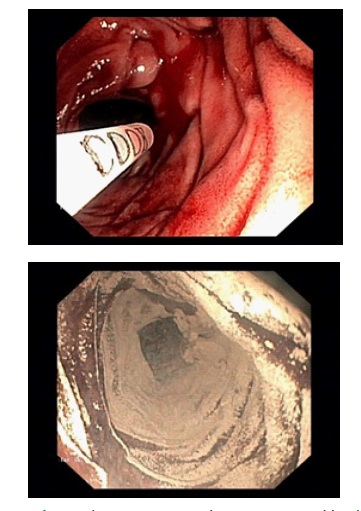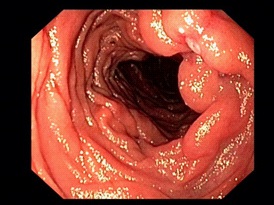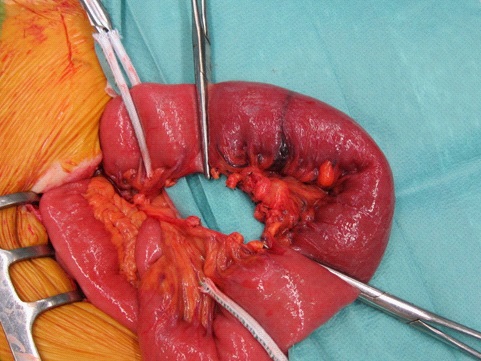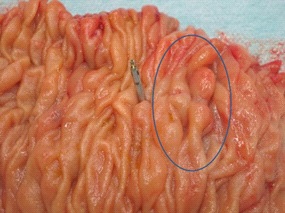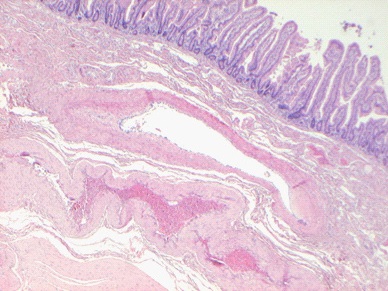
Journal of Clinical Images and Medical Case Reports
ISSN 2766-7820
Clinical Image - Open Access, Volume 3
Effective hemostasis by use of hemospray in a case of severe bleeding in the jejunum
Gabriele Wurm Johansson1; Artur Nemeth1; Stefan Santen2; Håkan Weiber2; Henrik Thorlacius2; Otto Ljungberg3; Ervin Toth1*
1 Department of Gastroenterology, Skåne University Hospital, Lund University, Malmö, Sweden
2 Department of Surgery, Skåne University Hospital, Lund University, Malmö, Sweden.
3 Department of Pathology, Skåne University Hospital, Lund University, Malmö, Sweden.
*Corresponding Author: Ervin Toth
Senior Consultant, Associate Professor, Department
of Gastroenterology, Skåne University Hospital,
Lund University, Malmö, 205 02 Malmö, Sweden.
Email: ervin.toth@med.lu.se
Received : Jan 19, 2022
Accepted : Mar 02, 2022
Published : Mar 09, 2022
Archived : www.jcimcr.org
Copyright : © Toth E (2022).
Citation: Johansson GW, Nemeth A, Santen S, Weiber H, Toth E, et al. Effective hemostasis by use of hemospray in a case of severe bleeding in the jejunum. J Clin Images Med Case Rep. 2022; 3(3): 1723.
Description
Gastrointestinal (GI) bleeding remains one the most common life-threatening emergencies associated with high morbidity and mortality and requires rapid and effective endoscopic hemostasis. Despite several available endoscopic hemostatic methods (injection therapy, mechanical and thermal therapy), the treatment of small bowel bleeding is still challenging, and successful hemostasis can be difficult to achieve. One of the novel topical hemostatic agents (Hemospray; Cook Medical, Winston-Salem, NC) was approved for the management of non-variceal upper GI bleeding, and clinical efficacy was shown for GI bleeding due to peptic ulcer, malignancy, gastric variceal hemorrhage, antithrombotic therapy, and lower GI bleeding [1- 5].
We report a case of successful application of Hemospray using a modified technique for balloon enteroscopy in a case with severe bleeding in the jejunum.
A 63-year-old woman was referred to the endoscopy unit due to signs of GI bleeding with a subacute history of hematemesis and recent melena. The initial hemoglobin level was 8.4 g/dl and INR was slightly increased. Hemodynamic parameters were stable.
Esophago-gastro-duodenoscopy and colonoscopy revealed no bleeding source. However, the patient returned with acute signs of GI bleeding, and a video capsule enteroscopy showed a diffuse bleeding in the proximal jejunum (Figure 1). A singleballoon-enteroscopy identified the bleeding 30 cm distal of the ligament of Treitz (Figure 2). Hemospray was topically applied on the bleeding site through a single-balloon-enteroscope with a modified technique, using a catheter with a stiff guidewire to avoid bending and accidental clotting of spray catheter (Figure 3). Second-look endoscopy 48 hours later showed a 2 X 2 cm large submucosal lesion with ulcerations as the bleeding source (Figure 4). The lesion was marked with clips and ink marked to facilitate later identification during surgery (Figure 5). The lesion was removed surgically (Figure 6), and the postoperative recovery was uneventful. Histological examination revealed a well-vascularized submucosal benign tumor (Figure 7).
References
- Chahal D, Sidhu H, Zhao B, et al. Efficacy of Hemospray (TC-325) in the Treatment of Gastrointestinal Bleeding: An Updated Systematic Review and Meta-analysis. J Clin Gastroenterol. 2021; 55(6): 492-498.
- Hussein M, Alzoubaidi D, Lopez MF, Weaver M, et al. Hemostatic spray powder TC-325 in the primary endoscopic treatment of peptic ulcer-related bleeding: multicenter international registry. Endoscopy. 2021; 53(1): 36-43
- Soulellis CA, Carpentier S, Chen YI, et al. Lower GI hemorrhage controlled with endoscopically applied TC-325 (with videos). Gastroint Endosc. 2013; 77: 504-7.
- Chen YI, Barkun AN, Soulellis C. Use of the endoscopically applied hemostatic powder TC-325 in cancer-related upper gastrointestinal hemorrhage: preliminary experience (with video). Gastrointest Endosc. 2012; 75: 1278-1281.
- Sung JJ, Luo D, Wu JC, et al. Early clinical experience of the safety and effectiveness of Hemospray in achieving hemostasis in patients with acute peptic ulcer bleeding. Endoscopy. 2011; 43: 291-295.


